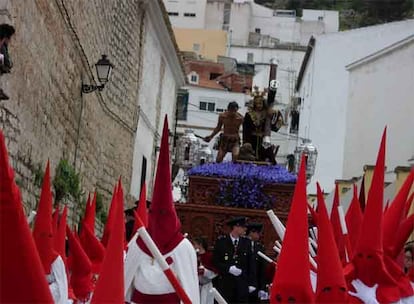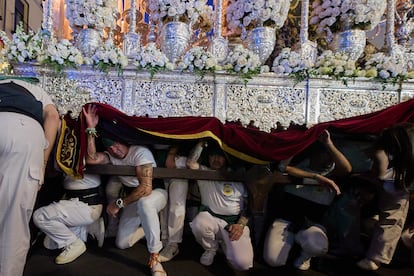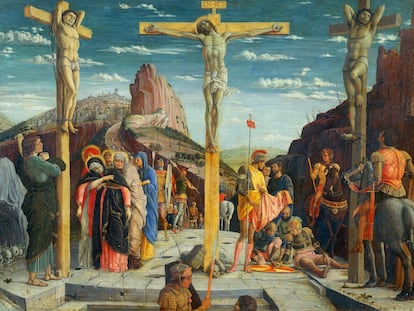Spain’s Holy Week, then and now
Texan writer Larry Belcher describes his first experience of the religious event in Jaén in 1971, and what has changed since then

In 1971, the “Bullfight of the Century” was to be televised in the United States, and although I would not travel to Spain for another five years, I was aware of who the bullfighter El Cordobés was. Jaén, on the other hand, was simply a tiny blue dot on a map in the atlas in my home in Dallas, Texas.
A dozen years later I was living in Salamanca, Spain, and my fiancé, Ana, began to tell me about Holy Week in Jaén, about costaleros, fabricanos, el paso sevillano camareras… baffling terminology. So in April we took a train from Atocha station in Madrid to that little blue dot in the south I had seen on a map so many years before.
In the old town on Palm Sunday, as I was wandering through the maze of streets that followed one another like a tedious argument, trying to decipher the name of one of the religious processions in the program — The Ancient and Illustrious Brotherhood of the Holy Christ of Clemency, Our Father Jesus Christ of the Fall, Saint Mary of Magdalen and Saintly Mary of the Greater Sorrow — I found myself before the door of the Gorrión Tavern. The year 1888 was carved in stone above the door. I pushed aside the heavy striped curtain in the doorway, stepped inside, and saw a petrified, cured ham hanging from the ceiling behind the bar. I would learn it had been preserved untouched since the Civil War in memory of the fallen and love lost. At the end of the bar, there were three posters of the Corridas [bullfights] Generales de Bilbao on the wall, arranged from left to right: 1931, 1929, 1928. The posters, like the tavern and the ham, led you into the past.
There is a Spanish term, querencia, which means a place in the bullring where a bull feels comfortable, where he will often take a stand and defend himself. I had discovered what was to become my querencia during Holy Week. My querencia then and now. When the tavern opened in the late morning there were few people and I would stand at the scarred, dark wooden bar and reflect on everything I had seen during the previous night’s processions, as well as what Ana and her friends from Jaén had explained to me while Paco, the owner, chalked the price of my glass of wine on the bar and turned to open cans of anchovies, sardines and tuna. There I met Jesús Rincón, a cultured and intelligent man who then, and now, spent long hours at the Gorrión bar, relating his vision of Holy Week and explaining to me the details of a world that was foreign to me. From the moment I set foot in the Gorrión, my daily pilgrimage became a habit: at night we went to the processions and then to the Gorrión, where we discussed what we had witnessed. In the mornings I usually went alone in order to attempt to assimilate that strange, often inscrutable, new world.

There was a great deal to assimilate. The processions themselves were no mystery, but what did surprise me were the commentaries and the discussions among the people. On Holy Monday night we were waiting for the procession of the Cristo de los Estudiantes in a bar on a dark street atop a hill and Ana and her friends were discussing whether or not the bearers should carry the huge, carved wood throne to a Sevillan rhythm, whether the throne looked better adorned with red carnations or with purple iris, and if there were fewer flowers this year. Also under discussion was whether the throne bearers — the costaleros — should bear the weight on both shoulders or “Málaga style,” on one shoulder. “This is serious,” I thought. Rumination in a bar with partridges in cages hanging from the ceiling, where the patrons were plucking small snails from tall glasses and sucking them from their shells, dropping them on the sawdust floor, and nibbling on fried rooster combs.
That Holy Monday night the 16th-century Cristo de los Estudiantes was borne up the hill accompanied by cornets and drums, sconces and moonlight, and we placed ourselves in front of the throne along with the few people remaining at 1 a.m. We walked slowly backward, facing the Christ, our pace in unison with the beat of the drums.

Rumination and snails remained in the bar.
The shuffling of the bearer’s feet on the cobblestones below the Christ rises up in the silence like sandpaper on wood. The foreman, the fabricano, sounds a metal clapper affixed to the front of the wooden throne: Clack! and shouts: “Halt! Halt!” The huge wooden throne is lowered until it rests on its four legs. The bearers emerge and sit on the cobblestones, towels rolled and placed on their shoulders to cushion the weight while the water bearers accompanying the procession walk among them.
A few of the penitentes — members of the brotherhood atoning for their sins — lift their white cowls in order to drink from plastic bottles, and the huge candles they carry create chiaroscuro silhouettes on the stone walls of the narrow street. At the order of the foreman, they resume their places, only their feet visible behind the drop cloth around the wooden throne. He sounds the clapper twice, and then once more as he shouts ¡arriba! The carved walnut Christ shivers, shudders and creaks as the throne is abruptly lifted onto the shoulders of the bearers and blood-red carnations fall to the stones below. A candle on the throne sputters and gutters out. Silence as the foreman commands: “One step to the left. One step forward. Now, arriba, slowly!” Under the throne, 40 bearers bellow in unison:“¡Arriba!” Tense, silent moments as the young men bearing the throne on their shoulders lift it slowly above their heads so that the Christ’s blood-streaked left arm nailed to the cross can pass over a balcony and then the spontaneous explosion of applause and cheers of “¡Viva el Cristo de los Estudiantes!” counterpoints the raucous outburst of drums and cornets that perforates the night. People on balconies above shower the Christ with flower petals and red and white carnations as he is carried up the dark and narrow street.
Holy Week. Curiouser and curiouser.
And thus began the routine of Holy Week, a routine that does not seem like routine: haste and hurry through the streets in order to be able to see the procession set in the perfect frame. Running and slipping through the throng and suddenly seeing the Cristo de la Expiración, a somber, elegant, imposing Christ as it is carried past a 17th-century church with open doors, candles flickering against stone columns inside. Hurry down the street where the Virgen de la Esperanza is parading by while the band behind her plays music that reminds you of a pasodoble in a bullring. But there is not much time to admire her flowing green robe. We must rush up a steep, narrow street to where the Brotherhood of Silence will parade through a small, intimate square enveloped by the scent of orange blossoms.

Now, tonight, so many years later, here above the town in the gypsy quarter, La Magdalena, the wind flirts with the white robes and the red cowls of the penitentes and gutters the candles inside the glass globes on the thrones of the Virgen María Santísima del Mayor Dolor and the Cristo de la Clemencia, imbuing the night with the acrid odor of incense and the smell of churros from the bakery next door. Opposite the church of Santísima María Magdalena on a balcony above the square, a flamenco singer of the Valderrama family dedicates a song, a saeta, to the Christ, bent and weary under the weight of the cross following the long night of procession:
Black as your hair is black,
Black as your dark agony,
Black as your dark suffering,
Black as the night is black.
Beside me a Roman soldier is sitting in the doorway of a bar drinking beer from a bottle, and in front of a house across the street where in the window there is a lighted model of the emblematic procession of Jaén — Nuestro Padre Jesús — a policeman is eating sunflower seeds and spitting the shells on the cobblestones.
The iris on the throne, softly and silently mauve in the moonlight, are beginning to wither, and there down below in the town rests the Gorrión, there in the past and in the present, as is the petrified ham hanging from the ceiling behind the bar. Here on a chilly night of procession the moon is full, 25-year-old sherry awaits in the Gorrión and tomorrow night the doors of the cathedral will swing open for the Cristo de la Buena Muerte.
Sign up for our weekly newsletter to get more English-language news coverage from EL PAÍS USA Edition
Tu suscripción se está usando en otro dispositivo
¿Quieres añadir otro usuario a tu suscripción?
Si continúas leyendo en este dispositivo, no se podrá leer en el otro.
FlechaTu suscripción se está usando en otro dispositivo y solo puedes acceder a EL PAÍS desde un dispositivo a la vez.
Si quieres compartir tu cuenta, cambia tu suscripción a la modalidad Premium, así podrás añadir otro usuario. Cada uno accederá con su propia cuenta de email, lo que os permitirá personalizar vuestra experiencia en EL PAÍS.
¿Tienes una suscripción de empresa? Accede aquí para contratar más cuentas.
En el caso de no saber quién está usando tu cuenta, te recomendamos cambiar tu contraseña aquí.
Si decides continuar compartiendo tu cuenta, este mensaje se mostrará en tu dispositivo y en el de la otra persona que está usando tu cuenta de forma indefinida, afectando a tu experiencia de lectura. Puedes consultar aquí los términos y condiciones de la suscripción digital.
More information
Últimas noticias
Most viewed
- Pablo Escobar’s hippos: A serious environmental problem, 40 years on
- Reinhard Genzel, Nobel laureate in physics: ‘One-minute videos will never give you the truth’
- Why we lost the habit of sleeping in two segments and how that changed our sense of time
- Charles Dubouloz, mountaineering star, retires at 36 with a farewell tour inspired by Walter Bonatti
- The Florida Keys tourist paradise is besieged by immigration agents: ‘We’ve never seen anything like this’










































